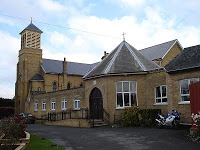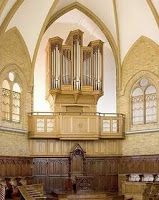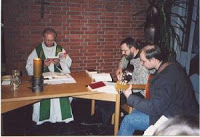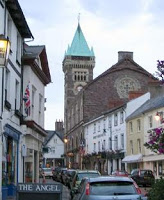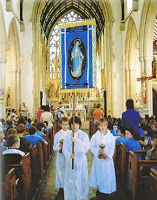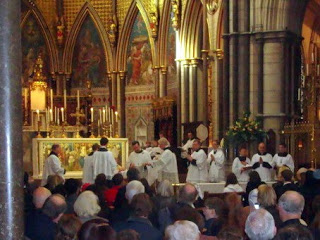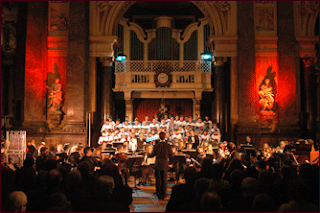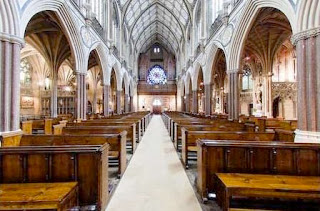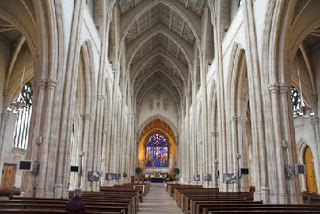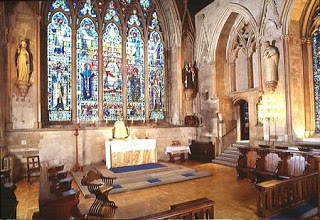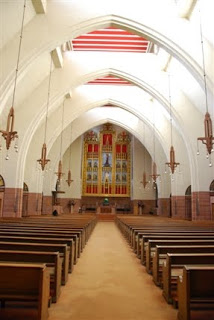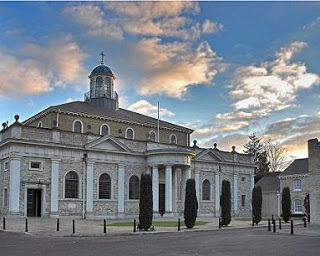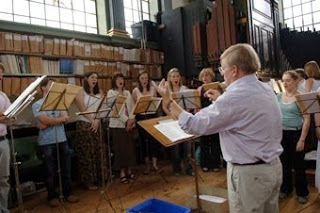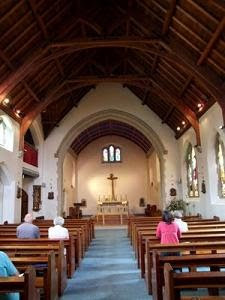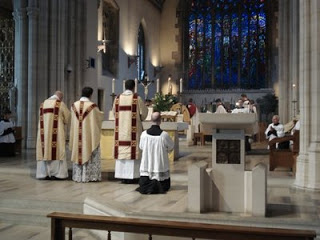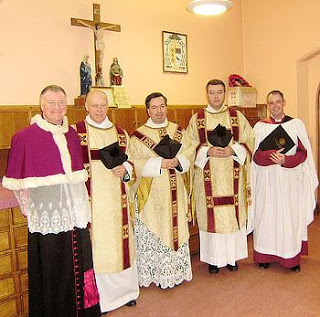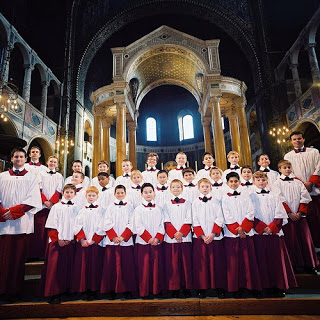Following on from Jeffrey’s interesting article about typical music lists in US parishes, I thought it would be an interesting exercise if I looked around London for what is on offer this coming Sunday. Whilst the majority of small churches offer an almost identically depressing diet of tripe to that available in the US, I was delighted to see that there are at least 13 Roman Catholic churches in London with choirs that sing both chant and polyphony on a weekly (or in the case of Westminster Cathedral, daily) basis. I thought readers may find the following interesting. The list is by no means comprehensive and is based on what details I could glean from web pages and quick telephone calls, but it does go some way to restore one’s faith in the Church and her music.
There is no particular order to the music list, simply the fist places that sprang to mind! It is also worth pointing out that London is, given its sheer size, split over 3 Dioceses. Two of the Cathedrals are in Central London (Westminster and Southwark) and are less than a mile from each other (one north and one south of the River Thames). The East End of London is largely covered by the Diocese of Brentwood whose Cathedral, though not strictly IN London, is very close and has diocesan territory in the City, hence its inclusion here.
The London (Brompton) Oratory deserves special mention. The London Oratory School Schola sings a the Brompton Oratory for the Saturday Vigil Mass. It has been listed separately here because there are two SATB choirs, one for Saturday (LOS Schola) and one for Sunday (The London Oratory Choir). The Sunday Choir, under the expert baton of Patrick Russill (Head of Choral Conducting and Church Music Studies at the Royal Academy of Music) also sings Solemn Vespers and Benediction every Sunday of the year, plus Solemnities. It also sings a regular Missa Cantata for major feasts in the Little Oratory. The LOS Schola, under the inspired direction of Lee Ward, is an internationally renowned liturgical and recording choir and is responsible for the soundtracks of all of the Lord of the Rings films and some of the Harry Potter films, to name but a few! It also sings, frequently with professional orchestral accompaniment, for the School Masses. The London Oratory Church also has a Junior Choir, under the talented direction of Charles Cole. This Choir sings the Family Mass every Sunday at the Oratory Church and has a diet of Chant and polyphony combined with congregational music. This Choir can also be heard on John Eliot Gardiner’s legendary CD of the Monteverdi Vespers of 1610, recorded in San Marco, Venice, for Deutsche Grammaphon’s Archiv label.
Music for Sunday 20 June 2010, London, UK
1) St James, Spanish Place (Latin, OF): Mixed adult professional choir; Rheinberger Mass in E flat Op. 109; Morales Inclina Domine; Organ: Franck Chorale No. 1; Full latin propers plus Credo III and sung Latin Confiteor (based on deacon’s sung Confiteor in EF)
2) London Oratory School Schola (English/Latin OF): Boys and adult male professional singers; Schubert Mass in G; Bruckner Ave Maria; Sanctus XI Orbis Factor; No Gregorian propers.
The LOS Schola in concert
3) Immaculate Conception, Farm Street (Latin, OF): Mixed adult professional choir; Flor Peeters Missa Laudis; George Malcolm Veritas mea; van Amelsvoort O quam admirailis; Organ: Widor Finale (Symphonie II); Full Gregorian propers plus Credo III & Domine, salvum fac Elizabeth
Immaculate Conception, Farm Street
4) Brompton Oratory (Latin, OF): Mixed adult professional choir; Organ: Reger Benedictus Op. 59 No. 9; Rheinberger Mass in E flat (Cantus Missae); Clemens non Papa Ego flos campi; Lassus O sacrum convivium; Organ: Rheinberger Introduction & Passacaglia (Sonata No.8); Full Gregorian propers plus Credo I
The London (Brompton) Oratory
5) Westminster Cathedral (English/Latin OF): Boys and adult male professional singers; Chapple Missa brevis Exoniensis (Kyrie & Gloria); Palestrina Exsultate Deo; Full Gregorian propers plus Credo III, Sanctus XI & Agnus Dei XI
Westminster Cathedral
6) St George’s Cathedral, Southwark (English/Latin, OF): Boys and adult male professional singers; Organ: Rheinberger Sonata 9 ii; Duruflé Messe ‘Cum Iubilo’ (Kyrie, Sanctus, Benedictus & Agnus Dei); Nicholas O’Neill Dominus Regit me; Organ: Rheinberger Sonata 3, i; Full Gregorian propers plus Gloria VIII, Credo III & Salve Regina (This Sunday is a men’s voices Sunday, the boys have the day off!)
St George’s Cathedral, Southwark
7) Ealing Abbey (English/Latin, OF): Boys and adult male professional singers; Duruflé Messe ‘Cum Jubilo’; Boyce The Lord is King; Palestrina Super flumina Babylonis; (Coincidentally, this Sunday is also a men’s voices Sunday, the Ealing Abbey boys too have the day off!)
8) St Etheldreda, Ely Place (Latin, OF): Mixed adult professional choir; Patronal Festival – Valls Missa Scala aretina (with violins, oboes and continuo); Valls Fiat misericordia; Full Gregorian propers plus Credo III & Salve Regina
9) Sacred Heart, Wimbledon (Latin, OF): Mixed adult amateur choir; Grayston Ives Missa Brevis; Stanford Beati quorum via; Wood Occuli omnium
Church of the Sacred Heart, Wimbledon
10) Carmelite Church, Kensington (Latin, OF): Exact details unavailable but there is a professional choir singing a full Latin Mass.
The Carmelite Church,
Kensington
11) Brentwood Cathedral (English/Latin, OF – 20 mins from London but whose Diocese covers a considerable part of the East End of London, hence its inclusion here): Mixed adult professional choir with boys, girls and volunteers; Palestrina Missa Papae Marcelli; Tallis O sacrum convivium; Some Gregorian propers & Credo III
12) Our Most Holy Redeemer and St Thomas More, Chelsea (Latin, OF): Mixed amateur (but excellent) choir; Hassler Missa a 8; Philips O quam suavis; Some Gregorian propers and Credo III
David Bevan, Director of Music, rehearses the
Choir of Holy Redeemer
13) St Dominic’s Priory, Hampstead: Mixed amateur choir singing Chant and polyphony. No details available for this Sunday.
St Dominic’s Priory, Hampstead
I offer my apologies to any churches which offer traditional music at their Sunday Masses – I merely blogged about those I know of. Please do add further details in the comment box below if you know of any other places with similar musical offerings.
The Church of St Bede, Clapham Park, offers a sung Solemn High Mass in the Usus Antiquior every Sunday and a Low Mass daily. There is occasionally a visiting professional choir for Solemnities. Otherwise, there is a small schola to lead the ordinary and propers on Sundays.
St Bede, Clapham Park
The Church of Our Lady of the Rosary, Blackfen (Greater London) has a sung Mass in the Usus Antiquior every Sunday with a small schola. They sing a Chant ordinary and some propers using Padre Rossini’s simplified version. On the first Saturday of the month the Latin Mass Society Schola sings the Propers for a Missa Cantata. The Parish Priest of this Church is the wonderful Fr Tim Finigan who has done so much to encourage the use of the EF and who does such fantastic work with his blog http://the-hermeneutic-of-continuity.blogspot.com/
Our Lady of the Rosary, Blackfen
The Oratory and St James, Spanish Place, have a Low Mass every Sunday. Many of these churches also offer a Solemn High Mass (with choir) in the Usus Antiquior on a reasonably regular basis.
Solemn High Mass at St George’s Cathedral, Southwark
(the Cathedral Choir can just be seen in the background)
Clergy and the blogger (NG – far right)
preparing for Solemn High Mass at Southwark
Whilst this is all very encouraging for Londoners, we can but hope and pray that this wonderful musical provision be extended to all the great cities and towns of Christendom.
Martin Baker, Master of Music, and
the Choir of Westminster Cathedral
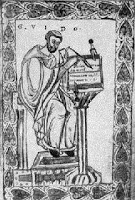
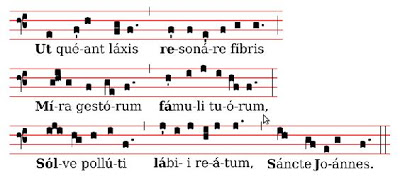
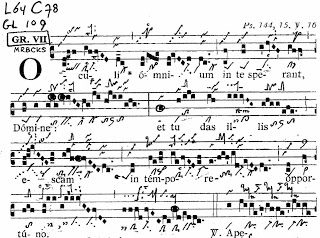
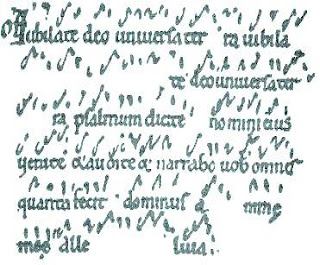
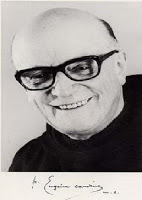






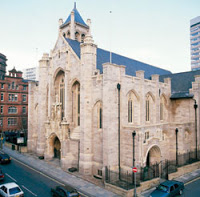 Now the Cathedral has a full-time music department, one of only three in Catholic cathedrals in
Now the Cathedral has a full-time music department, one of only three in Catholic cathedrals in 